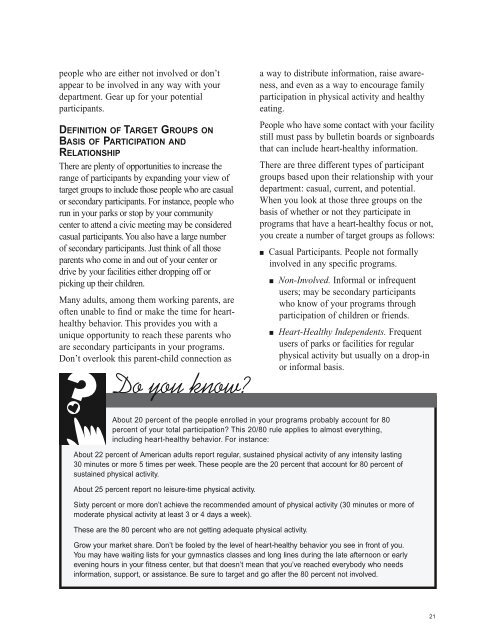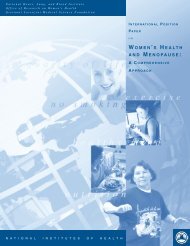HeartsNParks Community Mobilization Guide - National Heart, Lung ...
HeartsNParks Community Mobilization Guide - National Heart, Lung ...
HeartsNParks Community Mobilization Guide - National Heart, Lung ...
Create successful ePaper yourself
Turn your PDF publications into a flip-book with our unique Google optimized e-Paper software.
people who are either not involved or don’t<br />
appear to be involved in any way with your<br />
department. Gear up for your potential<br />
participants.<br />
DEFINITION OF TARGET GROUPS ON<br />
BASIS OF PARTICIPATION AND<br />
RELATIONSHIP<br />
There are plenty of opportunities to increase the<br />
range of participants by expanding your view of<br />
targetgroups to include those people who are casual<br />
or secondary participants. For instance, people who<br />
run in your parks or stop by your community<br />
center to attend a civic meeting may be considered<br />
casual participants. You also have a large number<br />
of secondary participants. Just think of all those<br />
parents who come in and out of your center or<br />
drive by your facilities either dropping off or<br />
picking up their children.<br />
Many adults, among them working parents, are<br />
often unable to find or make the time for hearthealthy<br />
behavior. This provides you with a<br />
unique opportunity to reach these parents who<br />
are secondary participants in your programs.<br />
Don’t overlook this parent-child connection as<br />
a way to distribute information, raise awareness,<br />
and even as a way to encourage family<br />
participation in physical activity and healthy<br />
eating.<br />
People who have some contact with your facility<br />
still must pass by bulletin boards or signboards<br />
that can include heart-healthy information.<br />
There are three different types of participant<br />
groups based upon their relationship with your<br />
department: casual, current, and potential.<br />
When you look at those three groups on the<br />
basis of whether or not they participate in<br />
programs that have a heart-healthy focus or not,<br />
you create a number of target groups as follows:<br />
■ Casual Participants. People not formally<br />
involved in any specific programs.<br />
■ Non-Involved. Informal or infrequent<br />
users; may be secondary participants<br />
who know of your programs through<br />
participation of children or friends.<br />
■ <strong>Heart</strong>-Healthy Independents. Frequent<br />
users of parks or facilities for regular<br />
physical activity but usually on a drop-in<br />
or informal basis.<br />
About 20 percent of the people enrolled in your programs probably account for 80<br />
percent of your total participation? This 20/80 rule applies to almost everything,<br />
including heart-healthy behavior. For instance:<br />
About 22 percent of American adults report regular, sustained physical activity of any intensity lasting<br />
30 minutes or more 5 times per week. These people are the 20 percent that account for 80 percent of<br />
sustained physical activity.<br />
About 25 percent report no leisure-time physical activity.<br />
Sixty percent or more don’t achieve the recommended amount of physical activity (30 minutes or more of<br />
moderate physical activity at least 3 or 4 days a week).<br />
These are the 80 percent who are not getting adequate physical activity.<br />
Grow your market share. Don’t be fooled by the level of heart-healthy behavior you see in front of you.<br />
You may have waiting lists for your gymnastics classes and long lines during the late afternoon or early<br />
evening hours in your fitness center, but that doesn’t mean that you’ve reached everybody who needs<br />
information, support, or assistance. Be sure to target and go after the 80 percent not involved.<br />
21
















